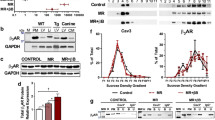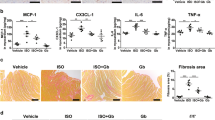Abstract
We demonstrated previously that adrenomedullin (AM), when given during early reperfusion, limited infarct size in rat heart. The present study was undertaken to provide direct evidence of the NO-dependency of AM’s cardioprotective action by assessing NO biosynthesis and involvement of the soluble guanylyl cyclase (sGC) pathway. Perfused hearts from male CD-1 mice were subjected to 30-min left coronary occlusion and 60-min reperfusion. Infarct size was determined by tetrazolium staining. AM 10 nM was administered from 20 min after coronary occlusion until 10 min after reperfusion. Coronary effluent was analysed for NO2 − and NO3 −, and myocardial samples were analysed for NO2 −, NO3 −, nitroso-adducts and cGMP concentration. To examine the role of NO/sGC signalling in the infarct-limiting action of AM, further hearts received the sGC inhibitor ODQ 2 μM. AM treatment stimulated NO synthesis, indicated by increased NO2 − efflux in coronary effluent throughout reperfusion (summarised as area under curve, AM 29.2 ± 3.9 vs. control 14.4 ± 2.8 μmol min2 mL−1, P < 0.05). AM limited infarct size (35.4 ± 2.7 vs. 12.2 ± 2.3%, P < 0.01), associated with a 2.45-fold increase (P < 0.05) in myocardial cGMP concentration at 10 min after reperfusion. ODQ abolished the infarct size-limiting effect of AM (28.9 ± 4.3%). These data provide the first evidence that AM increases NO bioavailability in intact murine myocardium and confirm that the NO/sGC/cGMP pathway is central to the cytoprotective action of AM against ischaemia–reperfusion injury.





Similar content being viewed by others
Abbreviations
- AM:
-
Adrenomedullin
- cGMP:
-
Guanosine-3′, 5′-cyclic monophosphate
- mPTP:
-
Mitochondrial permeability transition pore
- NO:
-
Nitric oxide
- NO2 − :
-
Nitrite
- NO3 − :
-
Nitrate
- NOS:
-
Nitric oxide synthase
- ODQ:
-
1H[1,2,4]oxodiazole-[4,3-a]-quinoxalin-1-one
- PI3K:
-
Phosphoinositol-3-kinase
- PKG:
-
Protein kinase G
- RXNOs:
-
Total nitros(yl)ated chemical species
- sGC:
-
Soluble guanylyl cyclase
References
Abdallah Y, Gkatzoflia A, Pieper H, Zoga E, Walther S, Kasseckert S, Schäfer M, Schlüter KD, Piper HM, Schäfer C (2005) Mechanism of cGMP-mediated protection in a cellular model of myocardial reperfusion injury. Cardiovasc Res 66:123–131
Burley DS, Baxter GF (2007) B-type natriuretic peptide at reperfusion limits infarct size in rat isolated heart. Basic Res Cardiol 102:529–541
Burley DS, Ferdinandy P, Baxter GF (2007) Cyclic GMP and protein kinase-G in myocardial ischaemia-reperfusion: opportunities and obstacles for survival signalling. Br J Pharmacol 152:855–869
Burley DS, Hamid SA, Baxter GF (2007) Cardioprotective actions of peptide hormones in myocardial ischemia. Heart Fail Rev 12:279–291
Cosby K, Partovi KS, Crawford JH, Patel RP, Reiter CD, Martyr S, Yang BK, Waclawiw MA, Zalos G, Xu X, Huang KT, Shields H, Kim-Shapiro DB, Schechter AN, Cannon RO 3rd, Gladwin MT (2003) Nitrite reduction to nitric oxide by deoxyhemoglobin vasodilates the human circulation. Nat Med 9:1498–1505
Costa AD, Garlid KD, West IC, Lincoln TM, Downey JM, Cohen MV, Critz SD (2005) Protein kinase G transmits the cardioprotective signal from cytosol to mitochondria. Circ Res 97:329–346
Csonka C, Szilvássy Z, Fülöp F, Páli T, Blasig IE, Tosaki A, Schulz R, Ferdinandy P (1999) Classic preconditioning decreases the harmful accumulation of nitric oxide during ischemia and reperfusion in rat hearts. Circulation 100:2260–2266
Duranski MR, Eldrod JW, Calvert JW, Bryan NS, Feelisch M, Lefer DJ (2006) Genetic overexpression of eNOS attenuates hepatic ischemia-reperfusion injury. Am J Physiol Heart Circ Physiol 291:H2980–H2986
Duranski MR, Greer JJ, Dejam A, Jaganmohan S, Hogg N, Langston W, Patel RP, Yet SF, Wang X, Kevil CG, Gladwin MT, Lefer DJ (2005) Cytoprotective effects of nitrite during in vivo ischemia-reperfusion of the heart and liver. J Clin Invest 115:1232–1240
Ferdinandy P, Schulz R, Baxter GF (2007) Interaction of cardiovascular risk factors with myocardial ischemia/reperfusion injury, preconditioning and postconditioning. Pharmacol Rev 59:418–458
Frantz S, Adamek A, Fraccarollo D, Tillmanns J, Widder JD, Dienesch C, Schäfer A, Podolskaya A, Held M, Ruetten H, Ertl G, Bauersachs J (2009) The eNOS enhancer AVE9488: a novel cardioprotectant protectant against ischemia reperfusion injury. Basic Res Cardiol [E-pub ahead of print, 23 Jun 2009]
Garthwaite J, Southam E, Boulton CL, Nielsen EB, Schmidt K, Mayer B (1995) Potent and selective inhibition of nitric oxide-sensitive guanylyl cyclase by 1H-[1, 2, 4]oxadiazolo[4, 3-a]quioxalin-1-one. Mol Pharmacol 48:184–188
Gross ER, Gross GJ (2006) Ligand triggers of classical preconditioning and postconditioning. Cardiovasc Res 70:212–221
Halestrap AP, Clarke SJ, Javadov SA (2004) Mitochondrial permeability transition pore opening during myocardial reperfusion—a target for cardioprotection. Cardiovasc Res 61:372–385
Hamid SA, Baxter GF (2005) Adrenomedullin: regulator of systemic and cardiac homeostasis in acute myocardial infarction. Pharmacol Ther 105:95–112
Hamid SA, Baxter GF (2005) Adrenomedullin limits reperfusion injury in experimental myocardial infarction. Basic Res Cardiol 100:387–396
Hamid SA, Baxter GF (2006) A critical cytoprotective role of endogenous adrenomedullin in acute myocardial infarction. J Mol Cell Cardiol 41:360–363
Hausenloy DJ, Ong SB, Yellon DM (2009) The mitochondrial permeability transition pore as a target for preconditioning and postconditioning. Basic Res Cardiol 104:189–202
Hausenloy DJ, Yellon DM (2007) Reperfusion injury salvage kinase signalling: taking a RISK for cardioprotection. Heart Fail Rev 12:217–234
Heusch G, Boengler K, Schulz R (2008) Cardioprotection: nitric oxide, protein kinases, and mitochondria. Circulation 118:1915–1919
Ikeda U, Kanbe T, Kawahara Y, Yokoyama M, Shimada K (1996) Adrenomedullin augments inducible nitric oxide synthase expression in cytokine-stimulated cardiac myocytes. Circulation 94:2560–2565
Ikenouchi H, Kangawa K, Matsuo H, Hirata Y (1997) Negative inotropic effect of adrenomedullin in isolated adult rabbit cardiac ventricular myocytes. Circulation 95:2318–2324
Ishimitsu T, Ono H, Minami J, Matsuoka H (2006) Pathophysiologic and therapeutic implications of adrenomedullin in cardiovascular disorders. Pharmacol Ther 111:909–927
Ishizaka Y, Ishizaka Y, Tanaka M, Kitamura K, Kangawa K, Minamino N, Matsuo H, Eto T (1994) Adrenomedullin stimulates cyclic AMP formation in rat vascular smooth muscle cells. Biochem Biophys Res Commun 200:542–546
Jones SP, Bolli R (2006) The ubiquitous role of nitric oxide in cardioprotection. J Mol Cell Cardiol 40:16–23
Kato K, Yin H, Agata J, Yoshida H, Chao L, Chao J (2003) Adrenomedullin gene delivery attenuates myocardial infarction and apoptosis after ischemia and reperfusion. Am J Physiol Heart Circ Physiol 285:H1506–H1514
Kehmeier ES, Kropp M, Kleinbongard P, Lauer T, Balzer J, Merx MW, Heusch G, Kelm M, Lepper W, Rassaf T (2008) Serial measurements of whole blood nitrite in an intensive care setting. Free Radical Biol Med 44:1945–1950
Khan SQ, O’Brien RJ, Struck J, Quinn P, Morgenthaler N, Squire I, Davies J, Bergmann A, Ng LL (2007) Prognostic value of midregional pro-adrenomedullin in patients with acute myocardial infarction: the LAMP (Leicester Acute Myocardial Infarction Peptide) study. J Am Coll Cardiol 49:1525–1532
Kitamura K, Kangawa K, Kawamoto M, Ichiki Y, Nakamura S, Matsuo H, Eto T (1993) Adrenomedullin: a novel hypotensive peptide isolated from human pheocromocytoma. Biochem Biophys Res Commun 192:553–560
Kuno A, Kuno A, Solenkova NV, Solodushko V, Dost T, Liu Y, Yang XM, Cohen MV, Downey JM (2008) Infarct limitation by a protein kinase G activator at reperfusion in rabbit hearts is dependent on sensitizing the heart to A2b agonists by protein kinase C. Am J Physiol Heart Circ Physiol 295:H1288–H1295
Looi Y, Kane KA, McPhaden AR, Wainwright CL (2006) Adrenomedullin acts via nitric oxide and peroxynitrite to protect against myocardial ischemia-induced arrhythmias in anaesthetized rats. Br J Pharmacol 148:599–609
Lundberg JO, Weizberg E (2005) NO generation from nitrite and its role in vascular control. Arterioscler Thromb Vasc Biol 25:915–922
Martin C, Schulz R, Post H, Boengler K, Kelm M, Kleinbongard P, Gres P, Skyschally A, Konietzka I, Heusch G (2007) Microdialysis-based analysis of interstitial NO in situ: NO synthase-independent NO formation during myocardial ischemia. Cardiovasc Res 74:46–55
Nakamura R, Kato J, Kitamura K, Onitsuka H, Imamura T, Cao Y, Marutsuka K, Asada Y, Kangawa K, Eto T (2004) Adrenomedullin administration immediately after myocardial infarction ameliorates progression of heart failure in rats. Circulation 110:426–431
Nishikimi T, Horio T, Yoshihara F, Nagaya N, Matsuo H, Kangawa K (1998) Effect of adrenomedullin on cAMP and cGMP levels in rat cardiac myocytes and nonmyocytes. Eur J Pharmacol 353:337–344
Okumura H, Nagaya N, Itoh T, Okano I, Hino J, Mori K, Tsukamoto Y, Ishibashi-Ueda H, Miwa S, Tambara K, Toyokuni S, Yutani C, Kangawa K (2004) Adrenomedullin infusion attenuates myocardial ischemia/reperfusion injury through the phosphatidylinositol 3-kinase/Akt-dependent pathway. Circulation 109:242–248
Penna C, Cappello S, Mancardi D, Raimondo S, Rastaldo R, Gattullo D, Losano G, Pagliaro P (2006) Post-conditioning reduces infarct size in the isolated rat heart: role of coronary flow and pressure and the nitric oxide/cGMP pathway. Basic Res Cardiol 101:168–179
Rassaf T, Bryan NS, Kelm M, Feelisch M (2002) Concomitant presence of N-nitroso and S-nitroso proteins in human plasma. Free Radic Biol Med 33:1590–1596
Rassaf T, Bryan NS, Maloney RE, Specian V, Kelm M, Kalyanaraman B, Rodriguez J, Feelisch M (2003) NO adducts in mammalian red blood cells: too much or too little? Nat Med 9:481–482
Rassaf T, Flogel U, Drexhage C, Hendgen-Cotta U, Kelm M, Schrader J (2007) Nitrite reductase function of deoxymyoglobin: oxygen sensor and regulator of cardiac energetics and function. Circ Res 100:1749–1754
Ribatti D, Nico B, Spinazzi R, Vacca A, Nussdorfer GG (2005) The role of adrenomedullin in angiogenesis. Peptides 26:1670–1675
Sakata J, Shimokubo T, Kitamura K, Nakamura S, Kangawa K, Matsuo H, Eto T (1993) Molecular cloning and biological activities of rat adrenomedullin, a hypotensive peptide. Biochem Biophys Res Comm 195:921–927
Sato A, Canny BJ, Autelitano DJ (1997) Adrenomedullin stimulates cAMP accumulation and inhibits atrial natriuretic peptide gene expression in cardiomyocytes. Biochem Biophys Res Commun 230:311–314
Schulz R, Kelm M, Heusch G (2004) Nitric oxide in myocardial ischemia/reperfusion injury. Cardiovasc Res 61:402–413
Schulz R, Rassaf T, Massion PB, Kelm M, Balligand JL (2005) Recent advances in the understanding of the role of nitric oxide in cardiovascular homeostasis. Pharmacol Ther 108:225–256
Shichiri M, Hirata Y (2003) Regulation of cell growth and apoptosis by adrenomedullin. Hypertens Res 26(Suppl):S9–S14
Shindo T, Kurihara Y, Nishimatsu H, Moriyama N, Kakoki M, Wang Y, Imai Y, Ebihara A, Kuwaki T, Ju KH, Minamino N, Kangawa K, Ishikawa T, Fukuda M, Akimoto Y, Kawakami H, Imai T, Morita H, Yazaki Y, Nagai R, Hirata Y, Kurihara H (2001) Vascular abnormalities and elevated blood pressure in mice lacking adrenomedullin gene. Circulation 104:1964–1971
Shiva S, Gladwin MT (2009) Nitrite mediates cytoprotection after ischemia/reperfusion by modulating mitochondrial function. Basic Res Cardiol 104:113–119
Webb A, Bond R, MacLean P, Uppal R, Benjamin N, Ahluwalia A (2004) Reduction of nitrite to nitric oxide during ischemia protects against myocardial ischemia-reperfusion damage. Proc Natl Acad USA 101:13683–13688
Yin H, Chao L, Chao J (2004) Adrenomedullin protects against myocardial apoptosis after ischemia/reperfusion through activation of Akt-GSK signalling. Hypertension 43:109–116
Zweier JL, Wang P, Samouilov A, Kappusamy P (1995) Enzyme-independent formation of nitric oxide in biological tissues. Nat Med 1:1103–1104
Acknowledgments
GFB and SAH acknowledge support for this work provided by the British Heart Foundation (PG/03/030). The work was also sponsored in part by the German DFG (RA969/4-1 to TR, and GRK1089/TP3 to TR, MT and CD).
Author information
Authors and Affiliations
Corresponding author
Rights and permissions
About this article
Cite this article
Hamid, S.A., Totzeck, M., Drexhage, C. et al. Nitric oxide/cGMP signalling mediates the cardioprotective action of adrenomedullin in reperfused myocardium. Basic Res Cardiol 105, 257–266 (2010). https://doi.org/10.1007/s00395-009-0058-7
Received:
Revised:
Accepted:
Published:
Issue Date:
DOI: https://doi.org/10.1007/s00395-009-0058-7




